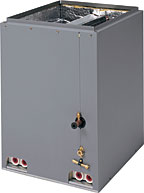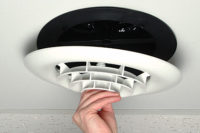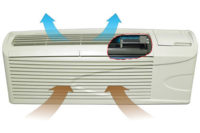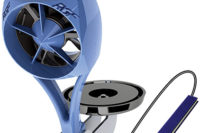
Contractors suffer from consumer pessimism when it comes to new products for the residential customer. Terms like zone control, heat pumps, tankless hot water heaters, UV light sterilization, electronic air cleaners, and energy recovery ventilator/heat recovery ventilator (ERV/HRV) are all foreign to most homeowners. Contractors may as well be selling flying washing machines. How then, does the contractor sell these new technologies?
The current push for energy efficiency has been a key to residential technology upgrades. Once introduced to the concept of saving large amounts of money for energy-efficient heating and cooling, residential customers are impressed and ready to buy. The initial installation cost, however, is a stunning deterrent, making customers quickly change their minds and revert to the lesser-priced option. So, how do contractors clinch the deal? Is there another benefit to new HVAC technology that customers aren't considering?

How About IAQ?
The Institute for Environmental Assessment (IEA) defines indoor air quality (IAQ) as the characteristics of the indoor climate of a building, including the gaseous composition, temperature, relative humidity, and airborne contaminant levels.According to the Environmental Protection Agency (EPA), the five most common pollutants are ground-level ozone, particulate matter, carbon monoxide, nitrogen dioxide, and sulfur dioxide. The Clean Air Act regulates these pollutants and measures them using the Air Quality Index (AQI).
Based on a scale of 0 to 500, 500 being the worst, the average safe AQI is between 50 to 100. Over 100, the environment is considered unhealthy for sensitive groups, people with heart or lung disease, older adults, and children. If over 200, it's considered unhealthy for everyone.
Though unacceptable in the outdoor environment, these pollutants pose a more eminent threat to the population's indoor environment. The EPA describes sick building syndrome (SBS), a growing problem in new and renovated buildings, as situations where building occupants experience acute health and comfort effects that appear to be linked to time spent in a building, with no significant illness or cause being identified.
According to the EPA, SBS is usually caused by inadequate ventilation, chemical contaminants, and biological contaminants. SBS can result in headache, dry cough, dizziness, nausea, fatigue, difficulty concentrating and eye, nose, or throat irritation.
It is the contractor's job to become educated and to educate the customer. According to the EPA, air pollution is one of the top four environmental risks that Americans face daily, and indoor air pollution is usually two to three times higher than outdoor pollution. EPA research also shows that Americans typically spend approximately 90 percent of their day indoors.
This large group of facts may get the customer's attention, but the contractor must directly relate these facts to the customer's situation in order to make them a believer.
Make The Call
Start the sales call normally. Identify what the customer needs and wants. Before offering the customer an HVAC solution, however, offer to conduct an IAQ test. Many contractors use portable hand-held monitors, such as the Fluke 983 particle counter. This meter determines airborne particle concentrations in the environment. According to Fluke, the 983 measures filter efficiency, locates particle sources for remediation, reports effectiveness of repairs to customers, and ultimately drives additional business by demonstrating a need for maintenance.Have the customer go with you and ask them the following questions:
Allow the customer time in between each question to think and then answer.
When the analysis is complete, return to the product literature and briefly educate the customer about IAQ and the outdoor environment (see sidebar below). If all goes well, the contractor should be able to add a whole-house air filtering system, such as the Trane CleanEffectsâ„¢, to the initial discussion of a furnace or air conditioner purchase.
According to Trane, Clean-Effects can provide up to 99.98 percent particle removal down to 0.3 microns, producing cleaner in-home air. It is composed of a three-layer system. The first layer is a pre-filter that traps a majority of the large particles. The air then passes through multiple-charged corona fields (small electrical fields), collecting more particles.
According to the company, this is more efficient than an electronic air cleaner because of the multiple electrical fields instead of a single-charged wire or metal plate. The final layers are only 0.08 inches apart with alternating charges used to trap particles as little as 0.3 microns. CleanEffects, as reported by Trane, has eight times the collection surface that keeps the filter from becoming clogged.

Don't Forget ERV
If the electronic air cleaner suggestion doesn't go over well, try suggesting an energy recovery ventilator (ERV) or a heat recovery ventilator (HRV). Honeywell's Perfect Windowâ„¢ Ventilation System provides all the benefits of fresh air in the home without the energy loss or safety concerns of an open window, according to Honeywell.An ERV is designed to capture the energy already used to condition inside air before it's exhausted from the home. This maintains energy efficiency and IAQ while bringing fresh air into the home. According to Honeywell, the Perfect Window meets the American Lung Association's Health House guidelines, recovers up to 80 percent of heating and cooling energy, and uses approximately the same amount of energy as a 100-watt light bulb.
Remind customers of the value of fresh air. A sealed environment seems to be the trend these days, but it can be hazardous. There must be a balance of indoor and outdoor air in order to create a positive pressure in the house. When questions are raised about why to buy technology to bring in polluted air, be sure to differentiate between fresh, new air, and clean air.

An Ounce Of Prevention
An ounce of prevention is better than a pound of cure. This is true for the IAQ industry and some of its new products. One can offer the customer an Armstrong AirEase antimicrobial coil. It is designed to resist mold and mildew growth, while keeping the evaporator drain line flowing freely.The coil drain pan is constructed from a polymer with an antimicrobial additive to resist mold and mildew growth, and because the drain pan is made from a polymer, it allows AirEase to claim it will never rust. The pan design is said to hold less water and the special grooves inside the coil are designed to increase heat transfer, according to AirEase.
Another possibility is to suggest a new whole-house humidifier. Skuttle Indoor Air Quality Products offers a 2100 Series Flow Thru humidifier equipped with the new Compustatâ„¢. According to Skuttle, the Compustat automatically adjusts humidifier output and adjusts to changes in the outdoor environment. This is designed to help prevent overhumidification.
Another mold prevention-air purification device is the Lennox Healthy Climate germicidal light. This ultraviolet (UV) light is designed to sterilize the coil surface. It is designed to eliminate and prevent microbial growth such as mold spores, viruses, and bacteria, breaking down their DNA, said Lennox. According to the company, it is the highest intensity UV germicidal light on the market, designed to reduce bioaerosols by 50 percent in less than one hour. Using a UV germicidal light is said to fight sickness, reduce allergies and asthma, and fight SBS.
Remember, use efficiency and IAQ as a one-two combination punch. Together, these strategies should be a knockout, raising per-call revenue and customer satisfaction.
Sidebar: The Five Most Common Pollutants And Their Effects
According to the Environmental Protection Agency (EPA), the five most common pollutants and their effects are:1. Ground-level ozone: Created by a chemical reaction between nitrogen oxides, volatile organic compounds (VOCs), and sunlight, it can travel long distances. Prolonged exposure can cause permanent lung damage. Lesser exposure lengths can cause wheezing, coughing, aggravated asthma, and reduced lung capacity.
2. Particulate matter: Describes particles in the air such as dust, dirt, soot, and smoke. These can lead to chronic bronchitis, painful breathing, and premature death.
3. Carbon monoxide (CO): According to the EPA, 78 percent of CO levels come from on-road vehicles, airplanes, and construction machinery. This pollutant can damage central nervous systems, cause respiratory issues, and contribute negatively to those with pre-existing heart problems.
4. Nitrogen dioxide: This is a reactive gas formed when fuel is burned at high temperatures that can cause acid rain, smog, and water quality deterioration. Exposure leads to damaged lung tissue, emphysema, and bronchitis. It also aggravates existing heart conditions.
5. Sulfur dioxide: The most common of the sulfur oxide gases, this gas occurs when coal and oil are burned; when gasoline is extracted from oil; and when metals are extracted from ore. Short-term exposure can cause temporary breathing difficulty for asthma sufferers. Long-term exposure at high levels has a tendency to cause respiratory illness and aggravate existing heart conditions.
- by Angela D. Harris
Publication date: 11/14/2005




